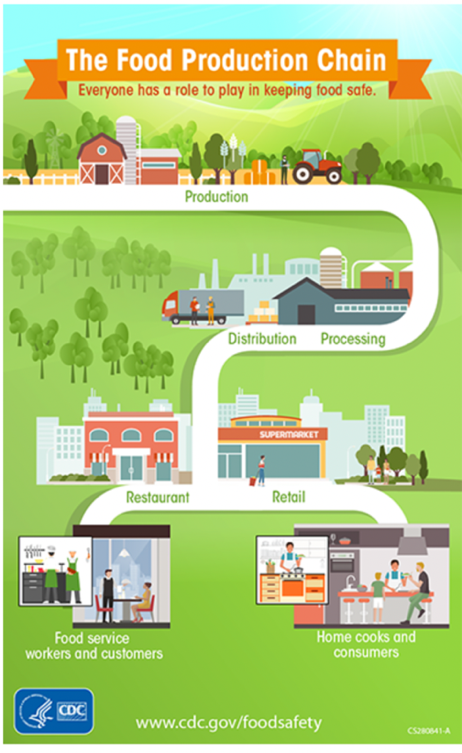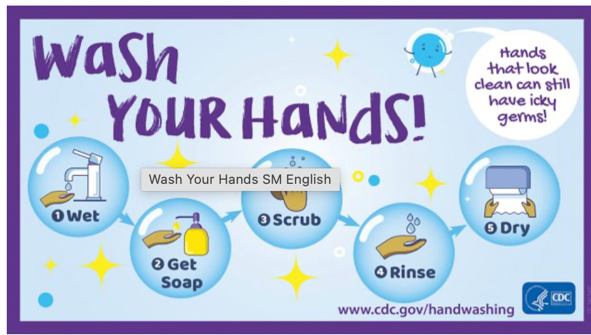Foodborne illness is caused by eating foods and beverages contaminated with various pathogenic bacteria, viruses, and parasites. The Centers for Disease Control (CDC) estimates that roughly 48 million people get some kind of foodborne illness each year.1 Of those 48 million people, 128,000 are hospitalized, and about 3,000 die.¹ Educating the public on proper food safety guidelines can help prevent many of these cases. It is helpful to understand what regulations and policies are in place for food safety throughout the food production chain and the steps consumers can take to reduce the chances of foodborne illness when handling and preparing food. This publication will assist Extension Agents, nutrition educators, and other audiences involved with or interested in food safety and offers a list of free educational resources for consumers. Clemson Cooperative Extension has several program areas that provide food safety education, including the Expanded Food and Nutrition Education Program (EFNEP) Team.
The US Food Production Chain

Figure 1. Infographic for the Food Production Chain. Image credit: Courtesy of the Centers for Disease Control and Prevention.2
Food production, processing, distribution, and preparation are the four points of the US food production chain (figure 1); contamination can happen anywhere along this chain.2 Regardless of where food is acquired and consumed, keeping food safe at every point is critical for reducing the potential for foodborne illness.² The Food Safety Modernization Act (FSMA) was passed in 2011 before being put into full effect in 2015 and has introduced significant changes to the US food chain.3 FSMA is the first set of regulations for the produce industry and provides federal oversight for our food system as a whole. Congress enacted FSMA to prevent foodborne illness instead of responding to outbreaks afterward.4
Production
Production entities, including produce and livestock farm operations, must comply with guidelines set by FSMA,5 and those guidelines include factors related to the environment. Appropriate farm management practices, such as those that address water and soil issues, are crucial for food safety. Contaminated irrigation water can introduce pathogens to fresh produce.2 Produce farms are typically based in farming regions and may be located near livestock farms. Water containing pathogens from livestock farms can run off into irrigation canals and contaminate water used to irrigate fresh produce.6 Waste from wild animals in produce fields can also introduce pathogens.6
Processing and Distribution
Equipment used to process animal parts and produce must meet applicable cleaning and sanitation standards. In animal products, the risk of cross-contamination is higher during processing because pathogens from the butchering process can be introduced to the final products distributed to consumer markets. Following processing, food must be kept safe during distribution to limit the growth and reproduction of pathogens. This includes keeping food at safe temperatures while in transit and at grocery stores and retail facilities where it is delivered.7
Preparation
Food preparation poses unique risks depending on where it is prepared and by whom. Restaurants and facilities serving food to the public must adhere to state and local regulations for food safety, including safe handling, temperature, and storage. Consumers should also practice the same standards when cooking at home to avoid foodborne illness.
Food Safety at Home
Research has shown that many consumers “generally underestimate” the potential severity of foodborne illnesses and their health impacts and overestimate the number of cases that come from food prepared outside the home.9,10 The majority of foodborne illness cases are comprised of individual cases and small outbreaks from food prepared inside the home.10 Therefore, it is crucial to communicate four messaging points for food safety at home: (1) cleaning—including personal hygiene, surfaces, utensils and produce; (2) cross-contamination; (3) adequate cooking temperatures; and (4) storage.11 An easy way to remember these is “Clean, Separate, Cook, and Chill.”11
Clean

Figure 2. Five steps for handwashing diagram. Image credit: Courtesy of Centers for Disease Control and Prevention.
Personal hygiene is essential. Studies show that handwashing is the best way to control pathogens from human feces or infected food handlers.12 Always wash your hands before, during, and after handling food (figure 2). Scrub your hands for at least twenty seconds. Singing the “Happy Birthday” song while scrubbing is a good way to keep time.13 Ensure that your counters, surfaces, and cooking tools are clutter-free and sanitized before, during, and after food preparation.13 Rinse your fruits and veggies.13 Consumers often think that meat and animal products pose a higher risk of foodborne illness; however, research shows that most foodborne illnesses come from fresh produce.14
Separate
Keep foods separate to avoid cross-contamination. Keep raw meat away from raw, fresh, and cooked produce. Do not wash meat, poultry, eggs or seafood as it can spread pathogens and increase the chance of foodborne illness.13 Make sure that your refrigerator is organized to reduce cross-contamination.11
Cook
Cooking food to adequate temperatures is key to avoiding the dangerous growth of pathogens.15 Table 1 provides safe minimum internal temperatures for different cooked foods.
Table 1. Safe minimum internal temperature chart for cooking different food. Adapted from FoodSafety.gov.15
| Food | Type | Internal Temperature (°F, °C) |
|---|---|---|
| Beef | Steaks, roasts | 145°F (63°C)
Rest time: 3 minutes |
| Ground meat and sausage | 160°F (71°C) | |
| Casseroles | Meat and meatless | 165°F (74°C) |
| Chicken, turkey, and other poultry | All: Whole bird, breast, legs, thighs, wings, ground poultry, giblets, sausage, stuffing inside poultry | 165°F (74°C) |
| Eggs | Raw eggs | Cook until yolk and white are firm |
| Egg dishes (such as frittata, quiche) | 160°F (71°C) | |
| Casseroles (containing meal and poultry) | 165°F (74°C) | |
| Leftovers | Any type | 165°F (74°C) |
| Pork | Steaks, roasts, chops | 145°F (63°C)
Rest time: 3 minutes |
| Ground meat and sausage | 160°F (71°C) | |
| Seafood | Fish (whole or filet) such as salmon, tuna, tilapia, pollock, bass, cod, catfish, trout, etc. | 145°F (63°C) or cook until the flesh is no longer translucent and separates easily with a fork |
| Shrimp, lobster, crab, scallops | Cook until flesh is pearly or white and opaque | |
| Clams, oysters, mussels | Cook until shells open during cooking |
Chill
Storing food at safe temperatures is vital for avoiding bacterial growth, and perishable foods should be refrigerated within two hours.13 Follow the proper guidelines for safe temperatures16:
- Refrigerators should be set at or below 40°F (4°C)
- Freezers should be set at 0°F (-18°C)
Visit FoodSafety.gov for a downloadable chart with additional guidelines for storing food in the refrigerator and freezer and time limits for storage.
Clemson Cooperative Extension Resources
Clemson Cooperative Extension provides unbiased, research-based information through an array of public outreach programs in youth development; agribusiness; agriculture; food, nutrition, and health; and natural resources. Program teams focusing on health, food safety, and nutrition include the Expanded Food and Nutrition Education Program (EFNEP), Rural Health, and 4-H Youth Development. The Extension Agents and Specialists of these teams provide education statewide to a multitude of stakeholders through various delivery methods, including virtual and in-person instruction, websites, and collateral materials.
EFNEP is the nation’s first federally funded nutrition education program for populations with limited financial resources. Prominent offerings include
- education at the community level to support participants in their “efforts towards self-sufficiency, nutritional health, and well-being,”
- science-based teaching techniques to ensure programs are efficient and effective and promote behavior change, and
- tracking of behavior change data in four key areas: (1) diet quality and physical activity, (2) food resource management, (3) food safety, and (4) food security.17
In South Carolina, EFNEP nutrition educators use the “Teen Cuisine” and the “Eating Smart Being Active” curricula to teach teens and adults about food safety, specifically how to focus on practicing personal hygiene, cooking food to safe temperatures, and avoiding cross-contamination. These are behaviors food safety educators emphasize to reduce instances of foodborne illness.10 In 2022 alone, 78% of adult and 60% of youth participants reported improvement in their food safety practices and knowledge.18 EFNEP programs are available in eighteen South Carolina counties. To find a program near you, visit Clemson Cooperative Extension’s EFNEP Program Team website.
Visit the Program Teams website to learn more about the programmatic and educational resources Clemson Cooperative Extension offers.
Additional Consumer Resources
- Partnership for Food Safety Education website (fightbac.org)
- CDC, Food Safety website (cdc.gov/foodsafety)
- USDA, National Institute of Food and Agriculture Food Safety website (nifa.usda.gov/topics/food-safety)
- USDA, Buy, Store & Serve Safe Food website (fda.gov/food/consumers/buy-store-serve-safe-food)
- University of Georgia, National Center for Home Food Preservation website (nchfp.uga.edu/)
- FoodSafety.gov website (foodsafety.gov)
References Cited
- Estimates of Foodborne Illness in the United States. Burden of Foodborne Illness: Overview. Washington (DC): CDC (Centers for Disease Control and Prevention); 2018 [accessed 2023 Aug 1]. https://www.cdc.gov/foodborneburden/estimates-overview.html.
- Food Safety. How Food Gets Contaminated – The Food Production Chain. Washington (DC): CDC (Centers for Disease Control and Prevention); 2022 [accessed 2023 Aug 10]. https://www.cdc.gov/foodsafety/production-chain.html.
- Food Safety, CDC and the Food Safety Modernization Act. Washington (DC): CDC (Centers for Disease Control and Prevention); 2022 [accessed 2023 Nov 13]. https://www.cdc.gov/foodsafety/fsma/index.html.
- Food Safety Modernization Act (FSMA). Washington (DC): FDA (U.S. Food and Drug Administration); 2023 [accessed 2023 Aug 18]. https://www.fda.gov/food/guidance-regulation-food-and-dietary-supplements/food-safety-modernization-act-fsma.
- FSMA Rules and Guidance for Industry. Washington (DC): FDA (U.S. Food and Drug Administration); 2023 [accessed 2023 Aug 18]. https://www.fda.gov/food/food-safety-modernization-act-fsma/fsma-rules-guidance-industry#rules.
- Research. Davis (CA): WCFS (Western Center for Food Safety), University of California, Davis, US Food and Drug Administration; 2019 [accessed 2023 Nov 15]. https://www.wcfs.ucdavis.edu/research/.
- Mercier S, Villeneuve S, Mondor M, Uysal I. Time-temperature management along the food cold chain: A review of recent developments. Comprehensive reviews in food science and food safety. 2017 Jul;16(4):647–67. doi:10.1111/1541-4337.12269.
- Yu H, Neal JA, Sirsat SA. Consumers’ food safety risk perceptions and willingness to pay for fresh-cut produce with lower risk of foodborne illness. Food Control, 2018 Apr [accessed 2023 Aug 1];86:83–89. doi:10.1016/j.foodcont.2017.11.014.
- Menini A, Mascarello G, Giaretta M, Brombin A, Marcolin S, Personeni F, Pinto A, Crovato S. The critical role of consumers in the prevention of foodborne diseases: an ethnographic study of Italian families. Foods. 2022 Mar 29;11(7):1006.
- Medeiros L, Hillers V, Kendall P, Mason A. Food safety education: what should we be teaching to consumers? Journal of Nutrition Education. 2001 Apr [accessed 2023 Oct 11];33(2):108–113. doi:10.1016/s1499-4046(06)60174-7.
- Four Steps to Food Safety: Clean, Separate, Cook, Chill. Washington (DC): CDC (Centers for Disease Control and Prevention); 2023 [accessed 2024 Feb 22]. https://www.cdc.gov/foodsafety/keep-food-safe.html.
- Show me the Science – Why Wash your hands. Washington (DC): CDC (Centers for Disease Control and Prevention); 2022 [accessed 2023 Aug 1]. https://www.cdc.gov/handwashing/why-handwashing.html.
- FoodSafety.gov. 4 Steps to Food Safety. Washington (DC): U.S. Department of Human and Health Services; 2023 [accessed 2023 Aug 1]. https://www.foodsafety.gov/keep-food-safe/4-steps-to-food-safety.
- Attribution of Foodborne Illness, 1998-2008. Washington (DC): CDC (Centers for Disease Control and Prevention); 2013 [accessed 2023 Sep 6]. https://www.cdc.gov/foodborneburden/attribution-image.html#foodborne-illnesses.
- Cook to a Safe Minimum Internal Temperature. Washington (DC): FoodSafety.gov. U.S. Department of Human & Health Services; 2023 [accessed 2023 Aug 1]. https://www.foodsafety.gov/food-safety-charts/safe-minimum-internal-temperatures.
- Are You Storing Food Safely? Washington (DC): FDA (U.S. Food and Drug Administration); 2023 [accessed 2023 Dec 11]. https://www.fda.gov/consumers/consumer-updates/are-you-storing-food-safely#:~:text=Also%2C%20when%20putting%20food%20away,F%20(%2D18°%20C).
- USDA. Expanded Food and Nutrition Education Program (EFNEP). Washington (DC): U.S. Department of Agriculture, National Institute of Food and Agriculture; 2022 [accessed 2023 Aug 1]. https://www.nifa.usda.gov/grants/programs/capacity-grants/efnep/expanded-food-nutrition-education-program
- USDA. EFNEP Impact Report 2022. Washington (DC): U.S. Department of Agriculture, National Institute of Food and Agriculture; 2022 [accessed 2023 Aug 1]. https://www.nifa.usda.gov/efnep-impact-report-2022.

